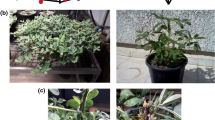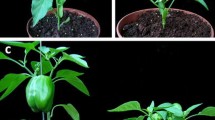Abstract
Flowering is a critical period during a plant’s life cycle, and thus the identification and characterization of genes involved in flowering date control are of great importance in agronomy, breeding, population genetics and ecology. The model species Medicago truncatula can be used to detect genes explaining the variation for flowering date, which could also explain this variation in legume crops. The objective of this study was to identify the most promising candidate gene explaining a major quantitative trait locus (QTL) for flowering date previously found in three M. truncatula mapping populations. Fine mapping and bioinformatic analysis of bacterial artificial chromosomes (BACs) in the confidence interval of the QTL showed six genes potentially involved in the control of flowering date. Two of these genes, similar to CONSTANS and FT of Arabidopsis thaliana respectively, had genomic mutations when compared to the parents. The transcriptomic study of these genes by semi-quantitative RT-PCR in leaves and flowers sampled at two developmental stages showed that the CONSTANS-like gene was differentially expressed in the two parental lines. A gene belonging to the CONSTANS-like family could explain the major QTL for flowering date segregating in M. truncatula progenies.



Similar content being viewed by others
References
Arcade A, Labourdette A, Falque M, Mangin B, Chardon F, Charcosset A, Joets J (2004) BioMercator: integrating genetic maps and QTL towards discovery of candidate genes. Bioinformatics 20:2324–2326
Aubert G, Morin J, Jacquin F, Loridon K, Quillet MC, Petit A, Rameau C, Lejeune-Henaut I, Huguet T, Burstin J (2006) Functional mapping in pea, as an aid to the candidate gene selection and for investigating synteny with the model legume Medicago truncatula. Theor Appl Genet 112:1024–1041
Barker D, Bianchi S, Blondon F, Dattée Y, Duc G, Essad S, Flament P, Gallusci P, Génier G, Guy P, Muel X, Tourneur J, Denarie J, Huguet T (1990) Medicago truncatula, a model plant for studying the molecular genetics of the Rhizobium-legume symbiosis. Plant Mol Biol Rep 8:40–49
Bell CJ, Dixon RA, Farmer AD, Flores R, Inman J, Gonzales RA, Harrison MJ, Paiva NL, Scott AD, Weller JW, May GD (2001) The Medicago Genome initiative: a model legume database. Nucleic Acids Res 29:114–117
Blazquez MA (2005) The right time and place for making flowers. Science 309:1024–1025
Broman KW, Wu H, Sen S, Churchill GA (2003) R/qtl: QTL mapping in experimental crosses. Bioinformatics 19:889–890
Chabaud M, Larsonneau C, Marmouget C, Huguet T (1996) Transformation of barrel medic (Medicago truncatula Gaertn) by Agrobacterium tumefaciens and regeneration via somatic embryogenesis of transgenic plants with the MtENOD12 nodulin promoter fused to the gus reporter gene. Plant Cell Rep 15:305–310
Cheng XF, Wang ZY (2005) Overexpression of COL9, a CONSTANS-LIKE gene, delays flowering by reducing expression of CO and FT in Arabidopsis thaliana. Plant J 43:758–768
Cheung W, Hubert N, Landry B (1993) A simple and rapid DNA microextraction method for plant, animal, and insect suitable for RAPD and other PCR analyses. PCR Methods Appl 3:69–70
Choi HK, Mun JH, Kim DJ, Zhu H, Baek JM, Mudge J, Roe B, Ellis N, Doyle J, Kiss GB, Young ND, Cook DR (2004) Estimating genome conservation between crop and model legume species. Proc Natl Acad Sci USA 101:15289–15294
Cook DR (1999) Medicago truncatula—a model in the making!. Curr Opin Plant Biol 2:301–304
Crespi MD, Jurkevitch E, Poiret M, Daubentoncarafa Y, Petrovics G, Kondorosi E, Kondorosi A (1994) Enod40, a gene expressed during nodule organogenesis, codes for a nontranslatable RNA involved in plant-growth. EMBO J 13:5099–5112
de Givry S, Bouchez M, Chabrier P, Milan D, Schiex T (2005) CAR(H)(T)AGene: multipopulation integrated genetic and radiation hybrid mapping. Bioinformatics 21:1703–1704
De Vienne D (1998) Les marqueurs moléculaires en génétique et biotechnologies végétales. INRA, Paris
Delalande M, Ronfort J, Prosperi JM (2004) Diversity for flowering time in a large collection of Medicago truncatula Gaertn. North American Alfalfa Improvement Conference, Québec
Fankhauser C, Yeh KC, Lagarias JC, Zhang H, Elich TD, Chory J (1999) PKS1, a substrate phosphorylated by phytochrome that modulates light signaling in Arabidopsis. Science 284:1539–1541
Flint-Garcia SA, Thornsberry JM, Buckler ES IV (2003) Structure of linkage disequilibrium in plants. Annu Rev Plant Biol 54:357–374
Gamas P, Debellé F, Berges H, Godiard L, Niebel A, Journet EP, Gouzy J (2006) Medicago truncatula cDNA and genomic libraries. Medicago truncatula Handbook
Griffiths S, Dunford RP, Coupland G, Laurie DA (2003) The evolution of CONSTANS-like gene families in barley, rice, and Arabidopsis. Plant Physiol 131:1855–1867
Hayama R, Coupland G (2004) The molecular basis of diversity in the photoperiodic flowering responses of Arabidopsis and rice. Plant Physiol 135:677–684
Hecht V, Foucher F, Ferrandiz C, Macknight R, Navarro C, Morin J, Vardy ME, Ellis N, Beltran JP, Rameau C, Weller JL (2005) Conservation of Arabidopsis flowering genes in model legumes. Plant Physiol 137:1420–1434
Huang T, Bohlenius H, Eriksson S, Parcy F, Nilsson O (2005) The mRNA of the Arabidopsis gene FT moves from leaf to shoot apex and induces flowering. Science 309:1694–1696
Huguet T, Gherardi M, Chardon F, Sartorel E, Prosperi JM, Chennaoui-Kourda H, Aouani ME (2007) Creation of a consensus genetic-physical (CGPM) for the identification of Medicago truncatula genes involved in natural variation. In: Huguet T, Aouani ME (eds), Model legume congress, 24–28 mars 2007 et Tunis. LILM-CECB, Tunis, pp 12
Imaizumi T, Kay SA (2006) Photoperiodic control of flowering: not only by coincidence. Trends Plant Sci 11:550–558
Julier B, Flajoulot S, Barre P, Cardinet G, Santoni S, Huguet T, Huyghe C (2003) Construction of two genetic linkage maps in cultivated tetraploid alfalfa (Medicago sativa) using microsatellite and AFLP markers. BMC Plant Biol 3:9
Julier B, Huguet T, Chardon F, Ayadi R, Pierre JB, Prosperi JM, Barre P, Huyghe C (2007) Identification of quantitative trait loci influencing aerial morphogenesis in the model legume Medicago truncatula. Theor Appl Genet 114:1391–1406
Komeda Y (2004) Genetic regulation of time to flower in Arabidopsis thaliana. Annu Rev Plant Biol 55:521–535
Koornneef M, Hanhart CJ, Vanderveen JH (1991) A genetic and physiological analysis of late flowering mutants in Arabidopsis thaliana. Mol Gen Genet 229:57–66
Lagercrantz U, Putterill J, Coupland G, Lydiate D (1996a) Comparative mapping in Arabidopsis and Brassica, fine scale genome collinearity and congruence of genes controlling flowering time. Plant J 9:13–20
Lagercrantz U, Putterill J, Coupland G, Lydiate D (1996b) Comparative mapping in Arabidopsis and Brassica, fine scale genome collinearity and congruence of genes controlling flowering time. Plant J 9:13–20
Lander ES, Botstein D (1989) Mapping mendelian factors underlying quantitative traits using RFLP linkage maps. Genetics 121:185–199
Le Corre V (2005) Variation at two flowering time genes within and among populations of Arabidopsis thaliana: comparison with markers and traits. Mol Ecol 14:4181–4192
Li Y, Roycewicz P, Smith E, Borevitz JO (2006) Genetics of local adaptation in the laboratory: flowering time quantitative trait loci under geographic and seasonal conditions in Arabidopsis. PLOS One 1:e105
Lifschitz E, Eviatar T, Rozman A, Shalit A, Goldshmidt A, Amsellem Z, Alvarez JP, Eshed Y (2006) The tomato FT ortholog triggers systemic signals that regulate growth and flowering and substitute for diverse environmental stimuli. Proc Natl Acad Sci USA 103:6398–6403
Locatelli AB, Federizzi LC, Milach SCK, Wight CP, Molnar SJ, Chapados JT, Tinker NA (2006) Loci affecting flowering time in oat under short-day conditions. Genome 49:1528–1538
Manichaikul A, Dupuis J, Sen S, Broman KW (2006) Poor performance of bootstrap confidence intervals for the location of a quantitative trait locus. Genetics 174:481–489
Marone M, Mozzetti S, De Ritis D, Pierelli L, Scambia G (2001) Semiquantitative RT-PCR analysis to assess the expression levels of multiple transcripts from the same sample. Biol Proced Online 3:19–25
Moreau D, Salon C, Munier-Jolain N (2006) Using a standard framework for the phenotypic analysis of Medicago truncatula: an effective method for characterizing the plant material used for functional genomics approaches. Plant Cell Environ 29:1087–1098
Nam YW, Penmetsa RV, Endre G, Uribe P, Kim D, Cook DR (1999) Construction of a bacterial artificial chromosome library of Medicago truncatula and identification of clones containing ethylene-response genes. Theor Appl Genet 98:638–646
O’Shea-Greenfield A, Smale ST (1992) Roles of TATA and initiator elements in determining the start site location and direction of RNA polymerase II transcription. J Biol Chem 267:1391–1402
Park SY, Nam YW (2006) Construction of a bacterial artificial chromosome library containing large BamHI genomic fragments from Medicago truncatula and identification of clones linked to hypernodulating genes. J Microbiol Biotechnol 16:256–263
Pierre JB, Huguet T, Barre P, Huyghe C, Julier B (2008) Detection of QTLs for flowering date in three mapping populations of the model legume species Medicago truncatula. Theor Appl Genet 117:609–620
Putterill J, Laurie R, Macknight R (2004a) It’s time to flower: the genetic control of flowering time. Bioessays 26:363–373
Putterill J, Laurie R, Macknight R (2004b) It’s time to flower: the genetic control of flowering time. Bioessays 26:363–373
Ronfort J, Bataillon T, Santoni S, Delalande M, David JL, Prosperi JM (2006) Microsatellite diversity and broad scale geographic structure in a model legume: building a set of nested core collection for studying naturally occurring variation in Medicago truncatula. BMC Plant Biol 6:28
Salathia N, Davis SJ, Lynn JR, Michaels SD, Amasino RM, Millar AJ (2006) FLOWERING LOCUS C-dependent and -independent regulation of the circadian clock by the autonomous and vernalization pathways. BMC Plant Biol 6:10
Skot L, Humphreys MO, Armstead I, Heywood S, Skot KP, Sanderson R, Thomas ID, Chorlton KH, Hamilton NRS (2005) An association mapping approach to identify flowering time genes in natural populations of Lolium perenne (L.). Mol Breed 15:233–245
Tadege M, Ratet P, Mysore K (2005) Insertional mutagenesis: a Swiss Army knife for functional genomics of Medicago truncatula. Trends Plant Sci 10:229–235
Tjaden G, Edwards JW, Coruzzi GM (1995) Cis-elements and trans-acting factors affecting regulation of a nonphotosynthetic light-regulated gene for chloroplast glutamine-synthetase. Plant Physiol 108:1109–1117
Trinh TH, Ratet P, Kondorosi E, Durand P, Kamate K, Bauer P, Kondorosi A (1998) Rapid and efficient transformation of diploid Medicago truncatula and Medicago sativa ssp falcata lines improved in somatic embryogenesis. Plant Cell Rep 17:345–355
Yamanaka N, Watanabe S, Toda K, Hayashi M, Fuchigami H, Takahashi R, Harada K (2005) Fine mapping of the FT1 locus for soybean flowering time using a residual heterozygous line derived from a recombinant inbred line. Theor Appl Genet 110:634–639
Young ND, Cannon SB, Sato S, Kim D, Cook DR, Town CD, Roe BA, Tabata S (2005) Sequencing the genespaces of Medicago truncatula and Lotus japonicus. Plant Physiol 137:1174–1181
Acknowledgments
The authors are very grateful to F. Durand, C. Gibelin and D. Cadier for their help in genotyping recombinants, gene sequencing and RT-PCRs, to J.F. Bourcier and J. Jousse for phenotyping the plants, to R. Minault and F. Gelin for greenhouse management and to M.R. Perretan and G. Boutet at INRA of Clermont-Ferrand for pseudo-F2 genotyping. J.B. Pierre received a Ph.D. grant from Région Poitou-Charentes.
Author information
Authors and Affiliations
Corresponding author
Electronic supplementary material
Below is the link to the electronic supplementary material.
Rights and permissions
About this article
Cite this article
Pierre, JB., Bogard, M., Herrmann, D. et al. A CONSTANS-like gene candidate that could explain most of the genetic variation for flowering date in Medicago truncatula . Mol Breeding 28, 25–35 (2011). https://doi.org/10.1007/s11032-010-9457-6
Received:
Accepted:
Published:
Issue Date:
DOI: https://doi.org/10.1007/s11032-010-9457-6




